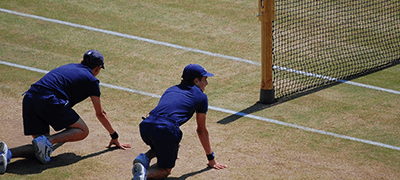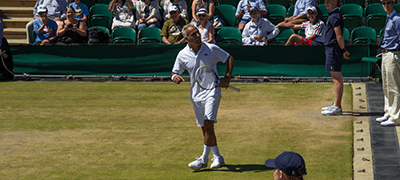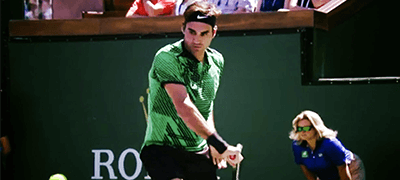Wimbledon Whites vs Colored clothing
Jun 28 6 min read
10:40 am
MG_6197 on Flickr by escribileamauro under CC2.0
In 2017, during a boys' doubles match at Wimbledon, play had to be halted as the top seeded pair of Zsombor Piros and Wu Yibing were asked to change their black colored underwear as they did not follow Wimbledon's dress code. The duo were each given a new pair of underwear and told to go and change immediately. A day later, 18-year old Jurij Rodionov was asked to change his underpants which bore the expression, "What seems to be the problem officer?" The officials caught hold of this as his underpants peaked out from above his shorts during some of his serves. He too was sent to the changing room immediately.
Over the years, players have fallen prey to Wimbledon's strict dress code. In 1972, the US Open became the first grand slam to allow the players to wear clothes of any colour. The Australian Open and Roland Garros started following that rule shortly after. However, Wimbledon stuck to its strict rule of "tennis whites."
Tradition is the only sponsor of Wimbledon. This is quite evident from its ad-free Center Court. The traditional aspect of SW19 is arguably what has kept Wimbledon as tennis' most prestigious tournament. One of the branches of this tradition is following a rigorous rule pertaining to the apparel that players wear during the tournament.
Tennis was initially played as a "genteel" sport. When Wimbledon officially commenced in 1877, the players wore a formal outfit, white in color. The men wore full-length shirts and trousers while the women wore corseted dresses. The players were very uncomfortable in this outfit and as a result could not express their shots freely. This led to the players taking a next step in dressing themselves in a way that would be compatible with their game play. May Sutton Bundy, who was the first American to win Wimbledon, complained that the sleeves were "too long and too hot." An exception was of five-time Wimbledon Champion, Lottie Dod. She was allowed to wear a calf-length skirt as she was still a schoolgirl when she played Wimbledon. She remains the youngest player to win Wimbledon at the age of 15 years.
It was Suzanne Lenglen who first broke ranks by wearing calf-length skirts in the 1920s. The men started wearing woolen flannel slacks and cable-stitched sweaters. This apparel was promoted by America's Bill Tilden. The outfit resembled the one worn by cricketers at the time. The women’s game saw the introduction of petticoats.
In 1929, the first tennis shirts for the men were introduced by Rene Lacoste. These shirts were extremely light in weight and hence helped players to improve their range of shots. Six years later, Henry Austin became the first male player to wear shorts in a tennis match. Sadly, it wasn't an accepted notion among tennis players and hence was discontinued. On the ladies side, Alice Marble became the first woman to wear shorts above the knee level at Wimbledon in 1937.
In 1949, Gussie Moran fell into controversy for wearing a short dress and lace knicker combination on court. The AELTC said that Moran brought sin and shame to tennis for wearing that outfit. Nearly a decade later, Karol Fageros received a ban for wearing gold coloured shorts. Meanwhile, former World No. 1 and three-time Wimbledon champion, Fred Perry wore the first polo t-shirts. Playing tennis became easier for men after this major change.
As the fabric improved, newer designs began to enter the market and even the women started to wear a masculine-styled outfit after the Open Era began. But players still fell victim to criticism for inappropriate dressing. In 1979, Linda Siegel faced a gunfire of reproval for wearing a low-cut top that gained the attention of spectators and organizers. Another addition to the list of players who were condemned for their dress code was of Anne White. In the 80s when tight skinned clothing began to gain popularity, White wore an all in one jumpsuit, which was distracting according to Pam Shriver. Shriver asked the organizers to ban White from the tournament. Pat Cash might have won the tournament in 1987 but his t-shirt failed to follow the norms of the Wimbledon dress code.
The reason why the All England Club decided to keep the clothing restricted to white colour was that the sweat spots on the clothes were less obvious in white. If not for the fixed colour, the players were critical about the rules that followed along with it.
In 2014, Wimbledon laid down a particular set of rules for the dressing of the players:
- Competitors must be dressed in suitable tennis attire that is almost entirely white and this applies from the point at which the player enters the court surround.
- White does not include off-white or cream.
- There should be no mass or panel or colouring. A single trim of colour around the neckline and around the cuff of the sleeve is acceptable but must be no wider than one centimeter.
- Colour contained within patterns will be measured as if it is a solid mass of colour and should be within the one centimeter guide. Logos formed by a variation of material or patterns are not acceptable.
- The back of a shirt, dress, tracksuit top or sweater must be totally white.
- Shorts, skirts, and tracksuit bottoms must be totally white except for a single trim of colour down the outside seam no wider than one centimeter.
- Caps, headbands, bandanas, wristbands, and socks must be totally white except for a single trim of colour no wider than one centimeter.
- Shoes must be almost entirely white, including the soles. Large manufacturers’ logos are not encouraged. The grass court shoes must adhere to the Grand Slam rules. In particular shoes with pimples around the outside of the toes shall not be permitted. The foxing around the toes must be smooth.
- Any undergarments that either are or can be visible during play (including due to perspiration) must also be completely white except for a single trim of color no wider than one centimeter. In addition, common standards of decency are required at all times.
- Medical supports and equipment should be white if possible, but may be coloured if absolutely necessary.
One of the biggest agitations was by Andre Agassi, who decided not to play Wimbledon until he turned 21. Nine-time Wimbledon Champion Martina Navratilova too faced a warning issued against her for wearing a blue striped skirt. Even the great Roger Federer was given a warning in 2013 for wearing white shoes with an orange coloured sole. In 2015 Genie Bouchard was warned by officials for wearing a black coloured sports bra. The then 21-year old nearly escaped an official sanction. Even Nick Kyrgios was warned in 2015 for wearing an official Wimbledon headband, which didn't stick to Wimbledon's dressing codes.
The fastidious rules of Wimbledon's dress code might be vexatious for the majority of players. But at the same time, it isn't a difficult task in getting yourself a mono coloured outfit after going through the 10-point decree.





















